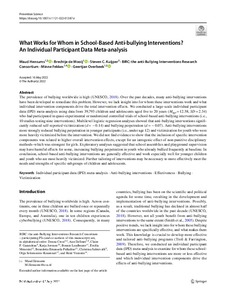What Works for Whom in School-Based Anti-bullying Interventions? An Individual Participant Data Meta-analysis
Joronen Katja; Overbeek Geertjan; Leadbeater Bonnie; Veenstra R.; Menesini Ersilia; Garandeau Claire F.; Hensums Maud; Salmivalli Christina; Fekkes M.; Solomontos-Kountouri Olga; Kuijper Steven C.; de Mooij Brechtje; Cross Donna; DeSmet Ann; Palladino Benedett Emanuela
https://urn.fi/URN:NBN:fi-fe2022091258595
Tiivistelmä
The prevalence of bullying worldwide is high (UNESCO, 2018). Over the past decades, many anti-bullying interventions have been developed to remediate this problem. However, we lack insight into for whom these interventions work and what individual intervention components drive the total intervention effects. We conducted a large-scale individual participant data (IPD) meta-analysis using data from 39,793 children and adolescents aged five to 20 years (Mage = 12.58, SD = 2.34) who had participated in quasi-experimental or randomized controlled trials of school-based anti-bullying interventions (i.e., 10 studies testing nine interventions). Multilevel logistic regression analyses showed that anti-bullying interventions significantly reduced self-reported victimization (d = − 0.14) and bullying perpetration (d = − 0.07). Anti-bullying interventions more strongly reduced bullying perpetration in younger participants (i.e., under age 12) and victimization for youth who were more heavily victimized before the intervention. We did not find evidence to show that the inclusion of specific intervention components was related to higher overall intervention effects, except for an iatrogenic effect of non-punitive disciplinary methods–which was strongest for girls. Exploratory analyses suggested that school assemblies and playground supervision may have harmful effects for some, increasing bullying perpetration in youth who already bullied frequently at baseline. In conclusion, school-based anti-bullying interventions are generally effective and work especially well for younger children and youth who are most heavily victimized. Further tailoring of interventions may be necessary to more effectively meet the needs and strengths of specific subgroups of children and adolescents.
Kokoelmat
- Rinnakkaistallenteet [19218]
